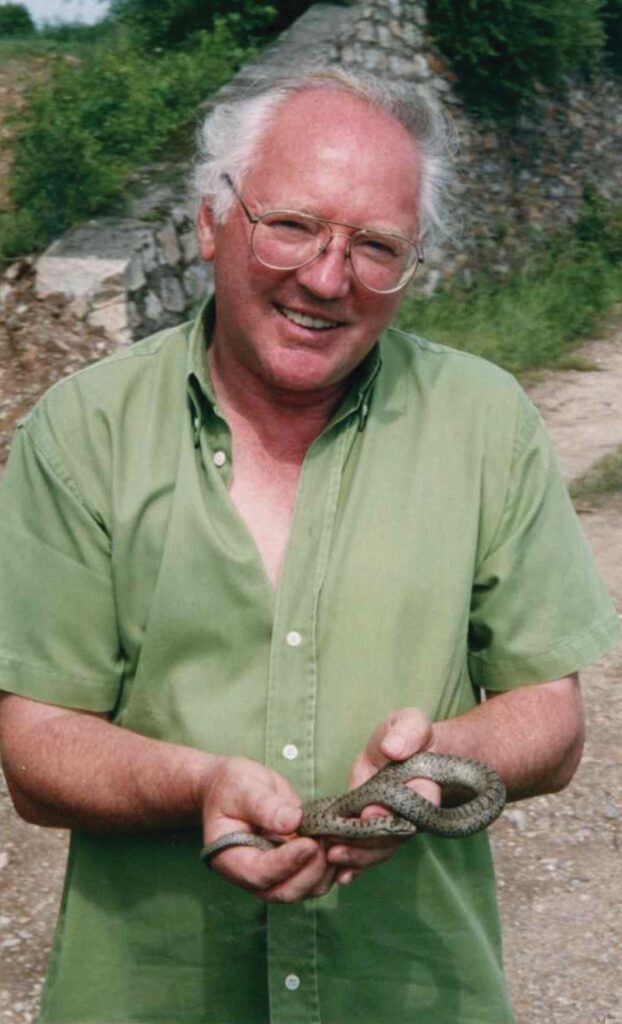
On 17th July 2025, the global herpetological community was saddened to hear of the death of Keith Corbett at the age of 84. It is no exaggeration to say that Keith was the catalyst for real action for the conservation of amphibians and reptiles in the UK and mainland Europe, dedicating his life to relentless campaigning and tireless hard work on their behalf.
Keith’s work in the UK started to gain momentum in the late 1960s as a result of his concerns about the lack of attention being paid to the declines of our rarest species, particularly the Sand Lizard, and the fact that many areas of heathland that supported these species were being destroyed. His formal field work started in 1967 as a University College of London PhD project and involved field studies of sites in Surrey and in Dorset to determine why Sand Lizards were declining – finding that lack of bare sand for egg-laying and lack of habitat management were the main reasons. At this time heathland continued to be lost to both residential and commercial development with no regard for wildlife. A similar situation was also at play in the coastal sand dune systems that supported populations of Natterjack Toads. The injustice of witnessing the destruction of sites that supported populations of such rare and special animals lit a burning passion in Keith that was never extinguished for the whole of his active life. His table thumping, at a time when the table really needed to be thumped, led to the first legal protection for the Sand Lizard, Smooth Snake and Natterjack Toad in 1975.
Keith then steered a path, with collaborators such as Professor Trevor Beebee, Jonathan Webster and Mike Preston, which led to the creation of the British Herpetological Society Conservation Committee (BHSCC) in 1969. This step initiated practical habitat management, mainly on heathland, for reptiles and amphibians. Keith’s engaging charm coupled with an uncompromising character helped gain the respect of many heathland landowners resulting in some pioneering yet enduring partnerships that survive to this day. After a period of unpaid employment as the BHSCC Conservation Officer, Keith was instrumental in setting up the Herpetological Conservation Trust (HCT) and became HCT’s first employee in 1989 as Conservation Officer, working hard to shape the organisation and its work ethic. He continued in this role until he retired in 2003 and in 2009 the HCT evolved into the Amphibian and Reptile Conservation Trust (ARC).
Keith then steered a path, with collaborators such as Professor Trevor Beebee, Jonathan Webster and Mike Preston, which led to the creation of the British Herpetological Society Conservation Committee (BHSCC) in 1969. This step initiated practical habitat management, mainly on heathland, for reptiles and amphibians. Keith’s engaging charm coupled with an uncompromising character helped gain the respect of many heathland landowners resulting in some pioneering yet enduring partnerships that survive to this day. After a period of unpaid employment as the BHSCC Conservation Officer, Keith was instrumental in setting up the Herpetological Conservation Trust (HCT) and became HCT’s first employee in 1989 as Conservation Officer, working hard to shape the organisation and its work ethic. He continued in this role until he retired in 2003 and in 2009 the HCT evolved into the Amphibian and Reptile Conservation Trust (ARC).
With other leading European herpetologists, Keith founded the Conservation Committee (CC) of the Societas Europaea Herpetologica and became chairman. Within that role, he organised trips for groups of expert herpetologists to remote places in Europe where the most threatened reptiles and amphibians survived. He edited a book on the situation in Europe in 1989, Conservation of European Reptiles and Amphibians (Christopher Helm, London), which to this day remains an important stake in the ground across the entire continent.
In recognition of his work in Europe, Keith received the United Nations Environmental Program Global 500 Role of Honour Award in 1991, an Honorary Doctorate from the University of Gothenburg in October 1994, and the Hungarian Government Order of Merit for Conservation in 1996. He was awarded the Honour of Member of the British Empire (MBE) in the 2000 New Years Honours list for services to conservation.
Keith was passionate, articulate and never afraid to speak his mind. Perhaps one of the best examples of that was the Judicial Challenge that he led and defended in court as a named individual (alongside Trevor Beebee, both representing the BHS, and WWF) against the then Bournemouth Council which, in the 1980s, had granted itself planning permission to build houses on Canford Heath in Dorset despite its notification as an SSSI. The Judicial Challenge resulted in Michael Heseltine, the Secretary of State at that time, revoking planning permission for the whole of Canford Heath.
Between 2003 and 2010, Keith and his wife Cathy lived in New Zealand where he campaigned hard for the active conservation of native skinks. His efforts helped provide the impetus for the creation of the New Zealand Lizards Conservation Toolkit, published by the Society for Research on Amphibians and Reptiles in New Zealand, which is still in use today.
Keith and his wife eventually settled in East Sussex where he was elected as a councillor for Newhaven Town Council, helping the local planners to understand the importance of treating ecological concerns seriously in planning applications.
Keith was always good company, a conversationalist with a great sense of humour and a great passion for German wines, an interest he successfully combined with trips to the Rhine Valley to look for Aesculapian Snakes at one of only a few locations for that species in Germany.
Keith Corbett was a remarkable person and the results of his campaigning have been making a difference for reptiles and amphibians for decades. His legacy of protecting habitats for these special species will continue to resonate for decades to come.
